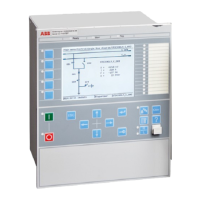selected to a value near the power transformer’s tap changer voltage step (typically 75 - 125%
of the tap changer step).
UDeadbandInner
: Setting value for one half of the inner deadband, to be set in percent of
UBase
. The inner deadband is symmetrical around
USet
, see section "Automatic voltage
control for a single transformer",figure 151. In that figure
UDeadbandInner
is equal to DU
in
. The
setting shall be smaller than
UDeadband
. Typically the inner deadband can be set to 25-70% of
the
UDeadband
value.
Umax
: This setting gives the upper limit of permitted busbar voltage (see section "Automatic
voltage control for a single transformer", figure 151). It is set in percent of
UBase
. If
OVPartBk
is set to
Auto&ManBlock
, then busbar voltages above
Umax
will result in a partial blocking such
that only lower commands are permitted.
Umin
This setting gives the lower limit of permitted busbar voltage (see section "Automatic
voltage control for a single transformer", figure 151). It is set in percent of
UBase
. If
UVPartBk
is set to
Auto Block
or
Auto&ManBlock
, then busbar voltages below
Umin
will result in a partial
blocking such that only raise commands are permitted.
Ublock
: Voltages below
Ublock
normally correspond to a disconnected transformer and
therefore it is recommended to block automatic control for this condition (setting
UVBk
).
Ublock
is set in percent of
UBase
.
Time
t1Use
: Selection of time characteristic (definite or inverse) for
t1
.
t1
: Time delay for the initial (first) raise/lower command.
t2Use
: Selection of time characteristic (definite or inverse) for
t2
.
t2
: Time delay for consecutive raise/lower commands. In the circulating current method, the
second, third, etc. commands are all executed with time delay
t2
independently of which
transformer in the parallel group that is tapping. In the master-follower method with the
follow tap option, the master is executing the second, third, etc. commands with time delay
t2
.
The followers on the other hand read the master’s tap position, and adapt to that with the
additional time delay given by the setting
tAutoMSF
and set individually for each follower.
tMin
: The minimum operate time when inverse time characteristic is used (see section "Time
characteristic", figure 152).
Line voltage drop compensation (LDC)
OpertionLDC
: Sets the line voltage drop compensation function
On
/
Off
.
OperCapaLDC
: This setting, if set
On
, will permit the load point voltage to be greater than the
busbar voltage when line voltage drop compensation is used. That situation can be caused by
a capacitive load. When the line voltage drop compensation function is used for parallel control
with the reverse reactance method, then
OperCapaLDC
must always be set
On
.
Rline
and
Xline
: For line voltage drop compensation, these settings give the line resistance and
reactance from the station busbar to the load point. The settings for
Rline
and
Xline
are given
in primary system ohms. If more than one line is connected to the LV busbar, equivalent
Rline
and
Xline
values should be calculated and given as settings.
When the line voltage drop compensation function is used for parallel control with the reverse
reactance method, then the compensated voltage which is designated “load point voltage” U
L
is effectively an increase in voltage up into the transformer. To achieve this voltage increase,
Xline
must be negative. The sensitivity of the parallel voltage regulation is given by the
magnitude of
Rline
and
Xline
settings, with
Rline
being important in order to get a correct
control of the busbar voltage. This can be realized in the following way. Figure
153 shows the
vector diagram for a transformer controlled in a parallel group with the reverse reactance
Section 13 1MRK 511 358-UEN A
Control
326
Application manual

